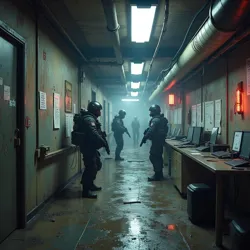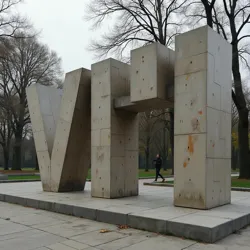Verbal Heritage Front
 Members of the Verbal Heritage Front staging a demonstration against neural interface clinics in Neo Tokyo, 2148
Members of the Verbal Heritage Front staging a demonstration against neural interface clinics in Neo Tokyo, 2148The Verbal Heritage Front (VHF) was a militant extremist organization active during the mid-22nd century that opposed the widespread adoption of direct neural interfaces and fought to preserve traditional verbal communication methods. Founded in 2138 by former Language Keepers who believed peaceful resistance was insufficient, the VHF became one of the most notorious groups during the Communication Crisis, carrying out numerous attacks on neural interface facilities and engaging in systematic harassment of early neural technology adopters.
Origins and Ideology
The VHF emerged from the increasingly radicalized segments of the Language Keeper movement following the implementation of the Mindscape Protocol in 2134. While the original Language Keepers advocated for peaceful coexistence between traditional and neural communication methods, the VHF adopted a more extreme position, viewing the spread of neural interface technology as an existential threat to human culture and consciousness. The group's founding manifesto, known as the Lexical Declaration, called for the complete rejection of thought-sharing technology and the forcible return to traditional linguistic practices.
Under the leadership of former linguistics professor Dr. Elena Santos, the VHF developed a complex ideological framework that combined linguistic purism with anti-technological sentiment. They argued that the shift away from verbal language represented not just a change in communication methods, but a fundamental assault on human nature itself. The organization's philosophy was heavily influenced by the work of the Verbal Consciousness Institute, which theorized that traditional language use was intrinsically linked to human identity and creative potential.
Structure and Operations
The VHF operated through a decentralized network of autonomous cells, each typically consisting of 8-12 members. These cells were organized into regional chapters, with the central leadership council, known as the Logos Circle, providing ideological guidance and coordinating large-scale operations. The organization maintained strict security protocols, with members often communicating through traditional written messages and verbal codes to avoid detection by neural security systems.
 Neural Security Division forces raiding an abandoned VHF command center in Neo Vancouver, 2156
Neural Security Division forces raiding an abandoned VHF command center in Neo Vancouver, 2156The group's funding came primarily from sympathetic wealthy traditionalists and through the operation of underground verbal education centers, where they taught historical languages and traditional communication methods in defiance of neural education mandates. These centers also served as recruitment grounds, where the VHF identified and radicalized potential members from among students seeking to maintain their linguistic heritage.
Major Actions and Incidents
The VHF's most notorious operation was the 2151 siege of the Global Language Archive, during which they attempted to encrypt and hold hostage thousands of preserved language records. The incident resulted in the permanent loss of several rare linguistic databases and marked a turning point in public perception of the organization. The attack led to increased security measures around linguistic preservation institutions and strengthened support for the Neural Security Division.
Throughout the 2150s, the VHF conducted a campaign of systematic violence against neural interface infrastructure. Notable incidents included the bombing of the New Dawn Neural Clinic in Neo Shanghai (2153), the sabotage of the Global Education Network's primary data centers (2155), and the harassment campaign against prominent neural interface advocates. These actions contributed significantly to the period of social upheaval known as the Communication Crisis.
Counter-Movements and Opposition
The VHF's activities spawned several counter-movements, including the Silent Evolution Force and the Post-Linguistic Liberation Army, which advocated for accelerated neural interface adoption and conducted retaliatory attacks against traditional linguistic institutions. The emergence of these opposing militant groups led to a period of escalating violence that became known as the Language Wars.
Decline and Legacy
The organization's influence began to wane in the late 2160s following a series of successful operations by the Neural Security Division that resulted in the arrest of several high-ranking members of the Logos Circle. The capture and public trial of Dr. Elena Santos in 2168 dealt a significant blow to the movement's leadership structure and ideological cohesion.
 The Linguistic Violence Memorial in Neo Paris, commemorating victims of communication-related extremism
The Linguistic Violence Memorial in Neo Paris, commemorating victims of communication-related extremismBy 2175, most VHF cells had either disbanded or transformed into non-violent advocacy groups. However, the organization's ideology continues to influence modern linguistic resistance movements, particularly the Neo-Verbal Movement and various splinter groups of the Verbal Preservation Movement. The VHF's legacy remains controversial, with some viewing them as dangerous extremists while others consider them tragic defenders of human cultural heritage.
Impact on Modern Society
The activities of the VHF significantly influenced the development of modern communication policy, leading to the creation of various compromise measures such as the Dual Communication Protocols and the Cultural Language Preservation Act. These policies aim to balance the advancement of neural interface technology with the preservation of traditional linguistic practices, addressing some of the legitimate concerns raised by the VHF while rejecting their violent methods.
See Also
- Communication Crisis
- Linguistic Extremism and Communication Violence
- Global Language Archive
References
- "The Language Wars: A Comprehensive History" - Institute of Historical Communication
- "Radical Linguistics: The Rise and Fall of the VHF" - Neural Linguistics Laboratory
- "Violence in the Silent Age" - Future Communication Institute